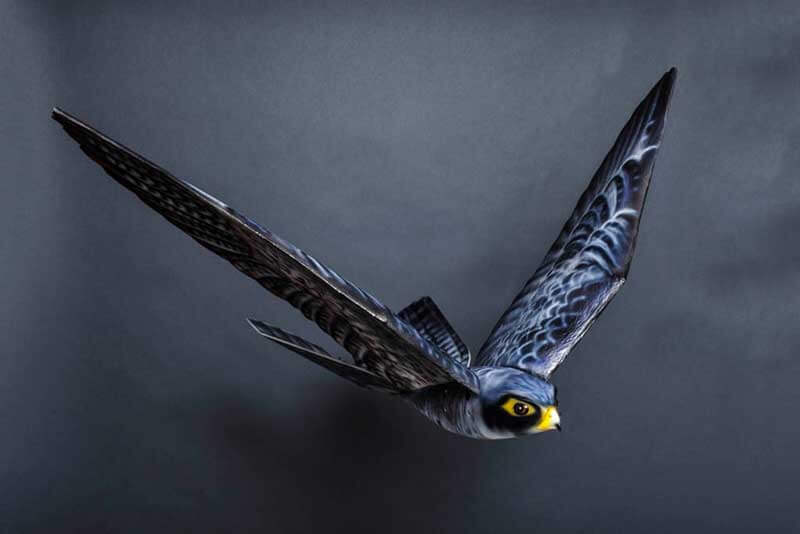- Robird chases away real birds to control pest populations
- A Chinese robot dove takes surveillance to new heights
- Drones virtually indistinguishable from real birds
Nature is an endless source of inspiration, and there’s hardly a more impressive sight than a bird flying through the air. From the first moment we saw a bird take flight, we’ve been striving to build machines capable of replicating that movement. This ambition gave rise to a wide variety of flying contraptions, including airplanes, helicopters, airships, gliders, and drones.
One trend in particular has become evident in recent years: the emergence of drones designed to mimic the look and movements of birds as realistically as possible, down to the flapping of the wings. These robotic birds could have a wide variety of applications, from chasing real birds away from our airports and crops to emergency response and surveillance.
Robird chases away real birds to control pest populations
As you may have already guessed from its name, Robird is a robotic bird developed by a Dutch company called Clear Flight Solutions, a University of Twente spin-off that specialises in unmanned aerial vehicles. The Robird looks and moves just like a real bird, flapping its robotic wings up and down as it glides across the sky at speeds of up to 80 kilometres per hour. In fact, the movement is so realistic that other birds will often mistake it for the real thing and flee the area. And that’s precisely what it was designed to do. According to the company, Robird is the most effective bird control method currently available on the market, capable of reducing pest bird populations by up to 75 per cent – and it’s completely humane!
The Robird is available in two different versions: the peregrine falcon and the eagle. The falcon weighs only 725 grams and can be used to scare away small and medium-sized birds. The eagle is a bit larger, weighing approximately 2 kilograms, which allows it to chase away all kinds of birds, regardless of their size. The bodies of both robotic birds are made from a nylon composite and glass fibre, and they’re powered by a lithium polymer battery.

In May 2017, Clear Flight Solutions signed a contract with the Edmonton International Airport, the largest Canadian airport by land area, to use the Robird to chase real birds away from active runways and prevent them from nesting in the area. “This is a historic step for the Robird and our company,” says Nico Nijenhuis, the CEO of Clear Flight Solutions. “We currently operate our Robirds in a variety of places, but taking the step towards full integration within daily operations at an airport is huge.”
In the past, Edmonton International Airport used sound effects and lasers to chase the birds away, but those methods haven’t proven particularly effective. The Robird has logged more than 200 flights since it was first introduced to the airport, successfully chasing away more than 10,000 birds in the process, and significantly reducing the risk of collision between birds and aircraft. “The applications [for] an ecologically friendly and impactful technology such as the Robird are huge,” says Jordan Cicoria from Aerium, a Canadian company that collaborated with Clear Flight Solutions on this project. “Airports, tailings ponds, wind farms, agriculture to name a few. The results are real in terms of safety, environment, and economics.”
A Chinese robot dove takes surveillance to new heights
China has also developed an incredibly realistic robotic bird, but this one has a slightly more sinister purpose – it’s used to spy on people. As a part of the Dove project, a team of scientists at Northwestern Polytechnical University in Xi’an, led by professor Song Bifeng, developed a robotic dove that’s already been deployed in China’s Xinjiang Uygur autonomous region. Sharing the border with Mongolia, Russia, Kyrgyzstan, Kazakhstan, Tajikistan, India, Pakistan, and Afghanistan, the region is viewed by the Chinese government as a hotbed for separatism and is subjected to heavy surveillance.
According to the scientists, their main goal was to develop a new generation of drones that would be able to go undetected not only by humans but also by radars. The robotic dove can mimic about 90 per cent of the movements of a real dove, including flapping its wings, climbing, diving, and turning in the air. The movement is so realistic that other birds will often mistake it for a real dove and fly next to it. Furthermore, it doesn’t produce much noise, which makes detection even harder.
The robotic dove has a wingspan of 50 centimetres and weighs only 200 grams. It can reach speeds of up to 40 kilometres per hour and stay in the air for 30 minutes. It’s equipped with an HD camera, a GPS antenna, a flight control system, and a data link with satellite communication capability. The flapping mechanism consists of two crank-rockers powered by an electric motor. When the bird moves up or down, its wings bend slightly to generate lift and thrust, while specially designed software keeps it steady and ensures that the images it takes are clear.
The scientists believe that the robotic dove could have applications that extend beyond police and military use, such as environmental protection, emergency response and disaster relief, and urban planning. “The scale is still small,” says Yang Wenqing, an associate professor at the School of Aeronautics at Northwestern. “We believe the technology has good potential for large-scale use in the future … it has some unique advantages to meet the demand for drones in the military and civilian sectors.”
However, as the technology is in relatively early stages, there are several issues that still need to be worked out. The bird has a very short range and its performance is severely affected by rain, snow, and strong winds. Furthermore, electromagnetic disturbance can wreak havoc on its electronic circuitry, while the lack of an anti-collision system makes it susceptible to crashing while flying at low altitudes.
Virtually indistinguishable from the real thing
They say that imitation is the sincerest form of flattery, and humanity has been trying to imitate nature since the dawn of time. Birds and their ability to fly have proven particularly fascinating to us, and this fascination has resulted in all kinds of flying machines over the years. As technology advanced, we became capable of mimicking the movements of birds more realistically, to the point that some robotic birds are now virtually indistinguishable from the real thing. Whether they’re used to scare other birds away from our airports and crops, provide disaster relief, or even spy on people, robotic birds are becoming an increasingly common sight in our skies. You may just not be aware of it yet.




